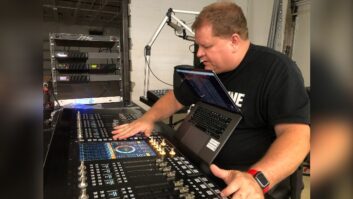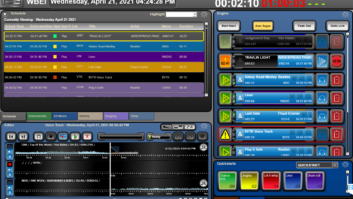For the past ten years, I have had the honor of representing Radio magazine at the NAB Show in Las Vegas. It�s an immersive experience that is educational and overwhelming.
It�s educational because broadcast companies from around the world gather to exhibit new products and introduce new ideas to our industry; and it�s overwhelming because of the information-overload that inevitably takes place!
The Logitek Helix is but one example of the virtualized control surface.
Photo Credit: Chris Wygal

By way of adding to this whirlwind of information, each year the Radio editorial staff charges me with two primary objectives: Walk the entire floor and see as many exhibitors as possible and � this is the biggie � keep an ear to the ground and sniff out a common trend. (It�s hard to sniff with your ear, but you get the idea.)
Prior to this year�s convention, finding a trend was difficult. It usually involved weaving together common threads that were represented by vastly different industry players.
For example, only a few years ago, minimal-footprint LED light panels and affordable 1080i cameras were paired to create a recipe for increased video creation in radio studios. Another year, we saw day-to-day �radio� functions migrating to smartphones. Then, the outbreak of high power solid state transmitters took the stage.
Specific to radio, last year�s NAB Show touted the explosion of AoIP and AES67. Whether we welcome the notion or detest it, broadcasting is dependent on IT infrastructure, now more than ever. Multipair cabling and even TDM technologies have faded into the past as we packetize our audio plants via IP switches and routers. Management systems like AES67 are being adopted at lightning speeds as we try to harness the IP world and streamline it for broadcast.
If that isn�t proof enough that our world is changing, consider this: the Broadcasting Engineering Conference held each year at the NAB Show changed its name to the Broadcast Engineering and Information Technology Conference. Yes, indeed. Times, they are a-changin�.
So that brings us to the trend that was gleaned from this year�s spring show. What stood out in the Radio Hall? What was the buzz?
VIRTUALIZATION
Words like �the cloud� floated (pun intended) throughout the convention.
Lawo�s Director of Virtual Projects Michael Dosch and Senior Project Manager Stephan Turkay delivered a presentation during which they coined the phrase �AoIP 2.0.�
Logitek�s Helix Radio Console as viewed from the side.

AoIP 2.0 is a convergence of IP power and PC power.
�The first wave of AoIP united physical devices via Ethernet. The second wave will take the software apps that replace those physical devices and unite them, using IP inside a virtual machine environment,� Dosch said.
How did his quote manifest on the exhibit floor? Obviously, through the Lawo CLEAR and R3LAY Virtual Radio Mixers.
But I personally saw it most clearly at Logitek. Their Helix console exists as a typical IP radio console, and it was prominently displayed at the front corner of their booth. But here�s where things changed.
A few steps away, that same Helix console existed on a crystal-clear Microsoft Surface Studio that was running the Helix app. It was remarkable.
The Surface Studio screen pivoted and articulated for optimal ergonomics, and the entire Helix console was virtually in front of me. I could touch the screen and operate faders and push buttons on a sleek, clean surface. The physical Helix console didn�t (dare I say this?) need to be there. The control was virtually onscreen at my fingertips.
To give credit where it�s due, note that Logitek�s virtual Helix console was mind-blowing, but the technology has been around for a while. Wheatstone and Axia, for example, have made virtual versions of their consoles available for some time.
For that matter, diverging away from the console discussion, the Report IT app from TieLine has made robust live reporting available on iPhones and Androids.
You might say, �But what about my trusty codec?� ipDTL is doing something similar. They have a web browser that can (using a computer) call landlines, send and receive ISDN calls and call cell phones. That�s all via IP.
If you thought we couldn�t go any further with virtualization, hold tight. Our microphones aren�t immune to the trend, either.
At the 2017 NAB Show, Audio Technica unveiled a dynamic microphone prototype with no more than an RJ-45 jack on the end of it. Inside the mic was the technology that made it IP-addressable. It was, in and of itself, a networkable audio device. With this, the only non-digital parts of the audio chain are the microphone element and the human voice.
We all know that broadcast engineers like toys. We get a kick out of seeing new stuff and an even bigger kick out of installing it. It�s why more than 100,000 NAB Show attendees converged on Las Vegas this year. We want to see what�s on the horizon and put our hands on it.
This is also where things get interesting.
I witnessed the virtualization discussion at the convention in April, and on social media and email list servers since. Nobody who attended the show was about to ignore the prevailing IP virtualization theme, and it sparked lively discussion. The response has been both positive and negative.
THE CONS
Virtualization is seen by some as robbing our profession of a tactile connection.
What�s the first thing we do when we see a radio console on display? We grab a fader and see how smoothly it tracks. We push a cue button to see how responsive it is. We turn a headphone volume knob.
Any audio technician or board op will attest to the fact that after some time, he or she can almost operate a familiar console blindfolded. There�s a human element involved in actually operating a physical piece of equipment.
A great example is a flight simulator. Flying a computer and flying an actual airplane are two different things.
I was talking to one engineer, and he said, �If I�m looking away and I need to ride a level, I can feel the fader with my hand and adjust accordingly. But if that fader is on a screen, how do I know where it is?�
Another engineer said, �I understand having all my playout and automation living on a PC. But we�re getting to the point where my entire station can live in the cloud, or at the very least on a couple of PCs in the corner of the room. What do I do when it crashes?�
However, the purpose of this article isn�t to answer those questions..
THE PROS
Virtualization is an impassioned topic of discussion for many broadcast engineers. And while plenty see the physical audio plant going up in a cloud (another intentional pun) of smoke, another group sees potential in the inherent scalability and cost-effectiveness of PC and IP based virtualization.
I�ll again refer to Lawo�s Stephan Turkay, who said, �We eliminated tape machines and carts 20 years ago in favor of PCs � and PC power has doubled many times over since then � but we still use it in the studio just for playout! There�s a lot we can do with that power.�
In many ways, the radio industry seems to be echoing Turkay�s sentiments. As time goes on and other sectors increasingly depend on and demand more IP and computing integration, broadcasters are doing the same.
When we look at a tablet or phone or touchscreen computer and see our broadcast operation living in a virtual environment it�s important to remember the 20-somethings who will soon inherit our broadcasting realm.
When some of them were only months old, they learned how to use touchscreen surfaces. The upcoming generation knows little to nothing about a 66-block or a balancing transformer. They know IP, and they are almost expecting technology to not just be �digital� but virtual.
To put this into perspective, a school group recently came by our studios for a tour. When they made their way to the engineering room, I demonstrated how I could access the radio consoles, AoIP interface, air processors and automation all on my iPhone.
The parents thought it was high-tech wizardry and were astounded that this kind of technology even exists.
The kids? They were ready for snacks.







